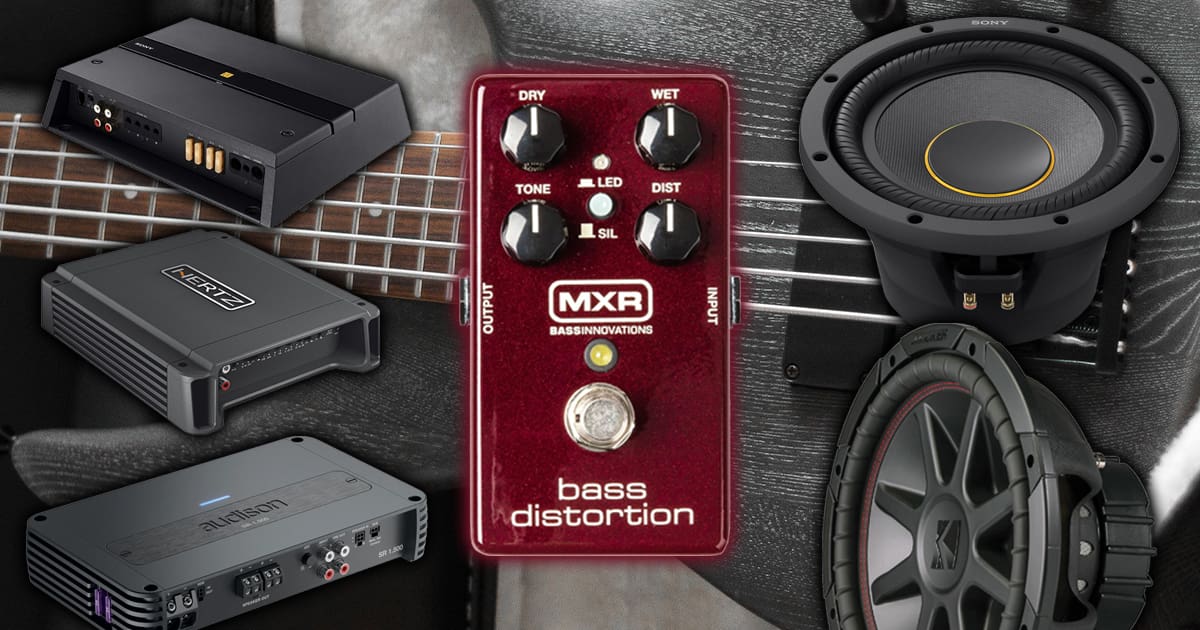At least once a week, someone comments on social media or in a forum that you can’t hear low-frequency distortion from subwoofers or amplifiers. We have no idea where this myth came from. However, if you understand what distortion is and how it works, you’ll know this myth is utter and complete nonsense. Yes, we know we’ve challenged the status quo. Don’t worry; we can always back up everything we say with science.
What Is Distortion?
In car audio systems, two types of distortion affect the accuracy of the sound reproduced by the audio equipment in our vehicles. Harmonic distortion creates audio information in multiples of the sounds the system produces. The second distortion is intermodulation distortion, or IMD, which adds unwanted audio content at frequencies that are the product of two different sounds. Yep, a mouthful. Let’s explain with examples.
Example of Harmonic Distortion
Let’s start by discussing harmonic distortion. Let’s say a performer plays a B1 note on a bass guitar. With conventional tuning, that would produce a sound with a fundamental frequency of 61.74 hertz. That’s well into the range in which most car audio subwoofers play. As with all sounds, natural harmonics are present to give the instrument its tone or character. For now, we will ignore those.
In a theoretically perfect audio system, the preamp, amplifier and speaker (or subwoofer) would reproduce this 61.74-hertz tone with no additional harmonic content. If we looked at this theoretically ideal system, we’d see a single spike on a spectrum analyzer at 61.74 hertz, as shown below.
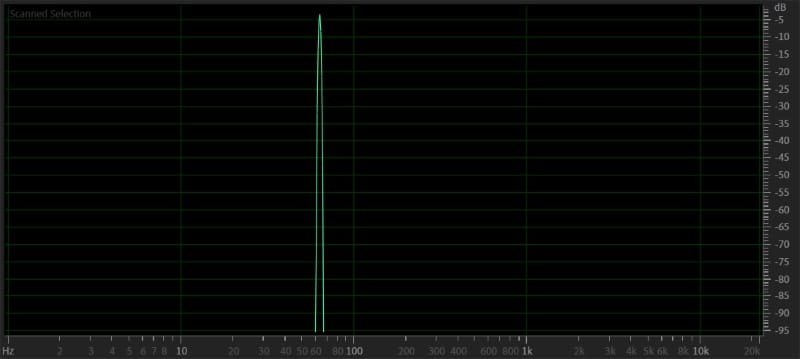
In the context of this discussion about distortion, nothing else shows in the spectral domain above an amplitude of -95 dB. We can say that the 61.74-hertz note has at least a harmonic distortion level that’s better than -92 dB. Why not -95? Well, the signal itself, in this example, was created at a level of -3 dB FS. We chose this level to leave room to add some harmonic content without inducing clipping. So, 95 minus three is 92. This -92 dB level equates to <0.002512% THD.
Let’s introduce some harmonic distortion. Harmonic distortion implies that the additional unwanted content is an even multiple of the fundamental frequency. We’ll throw in some 123.48- and 185.22-hertz information as an example.
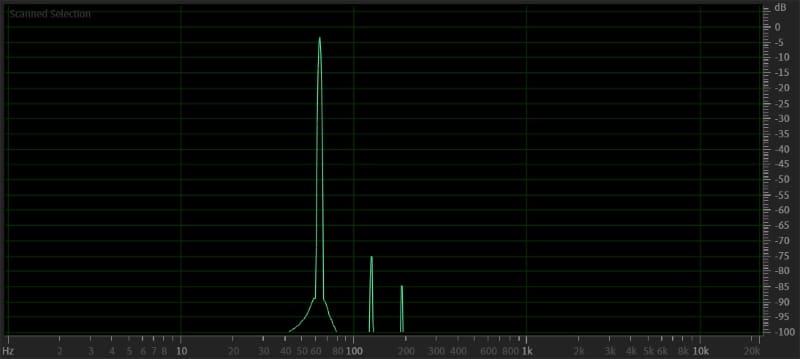
Amplifiers and Speakers Add Harmonic Distortion
The above is typical behavior for a car audio source unit and amplifier. We can see a second-order harmonic of 61.75 hertz at 123.48 hertz at a -75 dB FS level. A third-order harmonic at 185.22 is now present at -85 dB. If we combine the amplitude of those harmonics (with a bit of fancy math), we get a level of -74.5861. To compare that to our fundamental, we would subtract three (to compare to our fundamental frequency) for a distortion level of -71.5861 dB or 0.0263%.
Consider this for a second: We fed the amp with a signal with no more than 0.0025% distortion. That level equates to harmonic content below -95 dB FS. The amplifier has added content at 123 and 185 hertz because of distortion. This distortion is information above the low-pass crossover point. It’s information the subwoofer will try to reproduce.
Example of Intermodulation Distortion
OK, we now should understand how harmonic distortion works. We get unwanted multiples of any frequency that passes through the amplifier. What about intermodulation distortion? Let’s add a G1 note from our bass guitar to our musical experience. The G1 has a frequency of 49 hertz. This frequency is also well into the subwoofer region of a car audio system. Let’s look at G1 in the spectral domain.
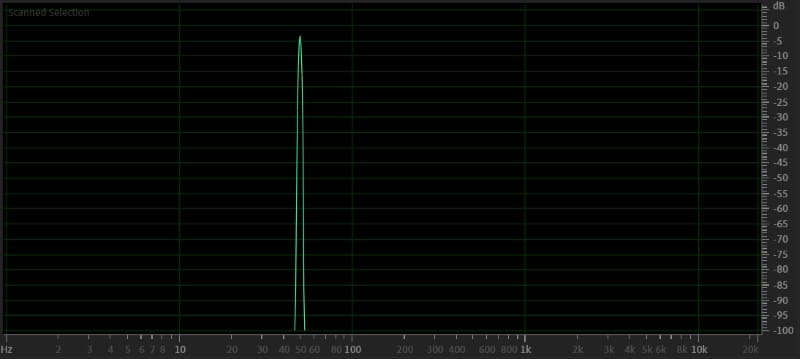
Nothing stands out as abnormal so far. We have our fundamental 49 hertz at a level of -3 dB FS, and nothing else. Once again, this means harmonic distortion is better than ~0.0025%. We won’t be talking about harmonic distortion, so we need to add that B1 note at 61.74 hertz to explain intermodulation distortion.
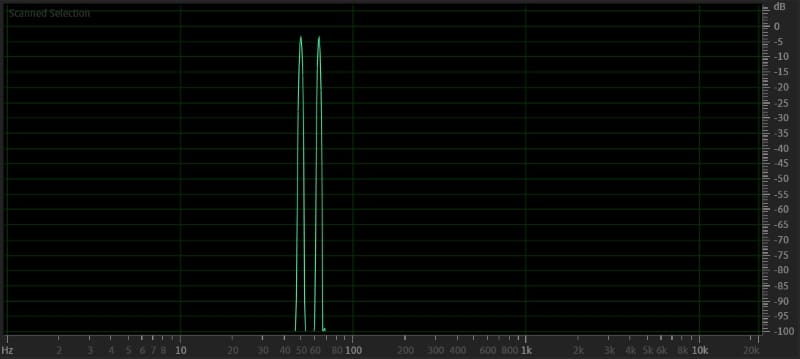
So far, everything looks logical and makes sense. We have two notes or sounds played simultaneously. Having two frequencies playing is a requirement for explaining how intermodulation distortion works. First, we need to do a little math. The difference between 49 and 61.74 hertz is 12.74, which is called the f2-f1 frequency.
Showing what IMD Looks Like
The first thing that happens when an amplifier adds IMD is the addition of audio information at this 12.74-hertz frequency. Let’s add it to our spectral frequency analysis graph.
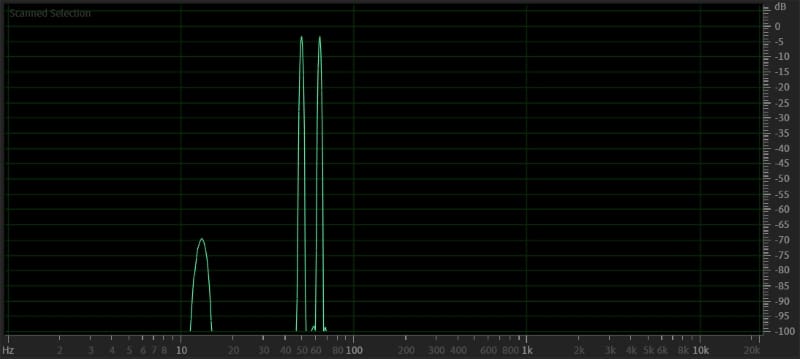
As you can see, the amplifier has added information that wasn’t in the original recording at this 12.74-hertz frequency. The f2-f1 frequency is only the first issue related to IMD. The second issue is sidebands, which are additional distortion frequencies spaced at 12.74 hertz (in this example) on either side of the fundamental frequencies. Here’s what one set of sidebands looks like on our graph.
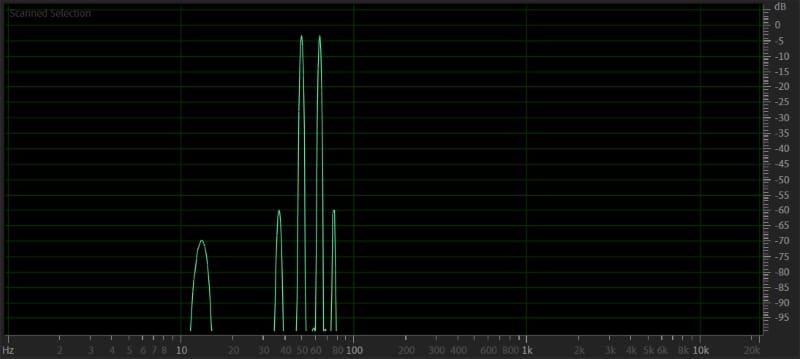
It’s easy to see that an amplifier or speaker that adds significant harmonic and intermodulation distortion would change how our music sounds. Remember that this is an example with only two frequencies playing, and we’ve excluded the harmonic content that the instruments would add naturally.
Every frequency from every instrument or performer is subjected to some harmonic and intermodulation distortion. Simultaneously, intermodulation distortion adds unwanted content between and on either side of every frequency.
Subwoofers and Hearing Low-Frequency Distortion
A while back, we published a short series of comparisons of subwoofers to analyze their distortion characteristics. A good-quality 10-inch subwoofer with robust excursion capabilities adds 2% to 3% total harmonic distortion between 40 and 100 hertz when playing at 90 dB SPL measured at 1 meter. Increase the output to 100 dB SPL, and you are in the 5% THD range. Yep, compared to electronics, speakers add a LOT of distortion.
Let’s reverse what that 5% distortion means if we play a 61.74-hertz note. Converting the percentage value back to a decibel number, we get -26.02 dB. To simplify the explanation, if the subwoofer created a single second-order harmonic (at 123.48 hertz), it would be 26.02 dB below the fundamental frequency. That would be very audible.
Let’s look at that in the spectral domain, shall we?
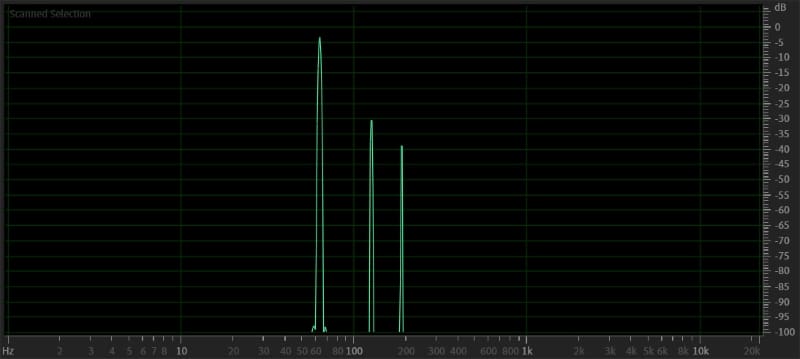
Here’s what you need to remember when looking at this chart: The information at 61.74 is the audio signal from the amplifier. As shown, it doesn’t contain any distortion. The nonlinearities of the subwoofer itself add the harmonics at 123.48 and 185.22 hertz. You will hear these sounds that were not in the original recording.
Subwoofer Crossover Points and Hearing Low-Frequency Distortion
Harmonic and intermodulation distortion add frequency content to an audio signal because of nonlinearities in a source unit, digital signal processor, amplifier, speaker or subwoofer. By a long way, speakers are the worst in the amount of distortion they add to audio signals. Choosing good speakers is crucial. Every component in the audio playback chain adds a bit of distortion. Well-engineered audio equipment adds less distortion. The result is that your music sounds more precise, more detailed and more accurate.
Let’s tie all this talk about distortion back into the context of low-frequency audio playback. First, we know that the harmonic distortion characteristics of an amplifier and the subwoofer itself will add audio information to what we hear. This harmonic content will primarily focus on the 60- to 250-hertz range. Above those frequencies, harmonic levels drop off to below audible levels as other audio information will mask them. There will also be intermodulation distortion content that’s mixed in with the original frequencies.
So what does this sound like? The higher frequencies cause the subwoofer itself to be much easier to locate in an audio system. We typically choose a steep crossover point around 80 hertz for the top of the sub. However, harmonics at relatively high levels, one or two octaves above that crossover point, can trick us into hearing the sub-bass from behind the listening position. Of course, this assumes your subwoofers are behind you in the vehicle. If the amplifier and sub were perfect and did not play any audio much above 80 hertz, it would be much harder to pinpoint the subwoofer in an audio system. Aside from time-alignment phase issues, if you can pick out the location of a subwoofer easily, it’s probably adding a lot of unwanted distortion.
Hearing Sounds Not in Your Music
From a tonal standpoint, a subwoofer system with moderate to severe distortion of harmonics usually sounds boomy or tubby rather than tight and dynamic. The addition of unwanted midbass harmonics changes the sound of the instrument. In our theoretical perfect recording, our bassist playing only that B1 note creates only audio content at 61.74 hertz. Once distortion has affected the signal, we hear more like a good pluck of the B1 and a little bit of B2 and B3. It’s just not the same thing. Now multiply that by every note they play. What you hear is a slightly different instrument. You’ll still know it’s a five-string bass, but it won’t sound the same.
A kick drum generates another good low-frequency sound that can be affected by unwanted distortion. The sound of the beater hitting a kick drum’s skin is unique. When analyzed critically, it’s easy to pick apart. Depending on the drum and its tuning, you might have a fundamental around 40 or 50 hertz for an 18- by 24-inch kick drum. In a good recording, you can pick out the sound of the beater hitting the drum head. You can also hear the resonance of the sound bouncing back and forth inside the body. Hearing this requires that the audio system be balanced correctly in the spectral domain and have the lowest distortion possible.
Is Bass Distortion as Easy to Pick Out as Midrange Distortion?
So, why does the myth that we can’t hear low-frequency distortion exist? Almost all of us are used to hearing voices. No, the voices with our ears, not the “in our heads” kind. Many of us talk with people almost nonstop every day. When there’s something wrong with a voice in a recording, it’s very easy to detect. However, let’s say you are someone like Mark Petrocelli. Mark is the drum technician for Styx drummer Todd Sucherman, considered one of the top drummers in the world.
As with many experts in the field of drumming, Mark and Todd can tell you when the head of a drum is too tight or loose just by listening; they can probably tell you whether Todd is using a different stick or whether a skin needs replacing. Musicians simply become attuned to the instruments they play. The same goes for listening to audio equipment. If you focus on the music – the lyrics and the sound — then most gear might sound good. If you focus on the sound of each instrument, picking them out from the mix and analyzing their timbre and timing, you become very good at picking out good quality audio gear from the mediocre.

Hearing Low-Frequency Distortion is Easy
So, is it easy to hear distortion at low frequencies? Of course it is. Are most people good at detecting this distortion compared with midrange frequencies? No, not at all. However, that doesn’t mean they don’t exist.
Let’s wrap this up with a quick story. Last year, we attended an industry trade show in Canada, where we had the opportunity to audition a half-dozen demo vehicles. The one that stood out was the one that used subwoofers with significant distortion-reducing technologies. The bass was several orders of magnitude more accurate than all the other vehicles’. There was more definition to each note and better separation. Adding a shorting ring and copper inductance-reducing pole piece cap to the subwoofer design made a huge difference.
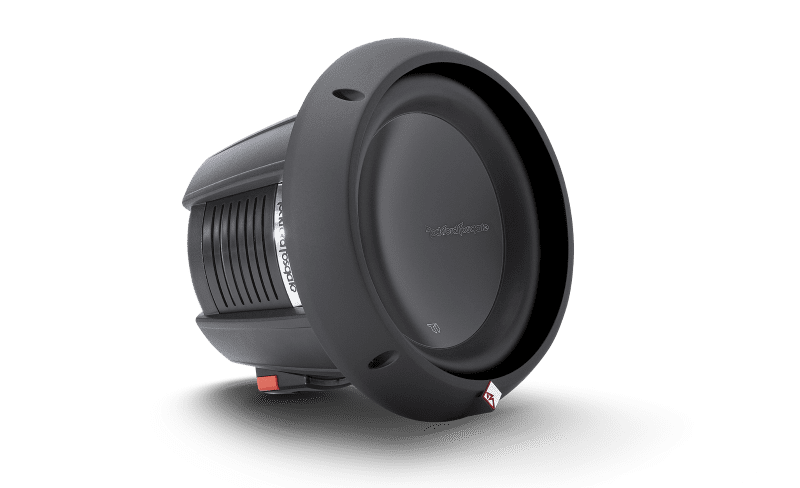
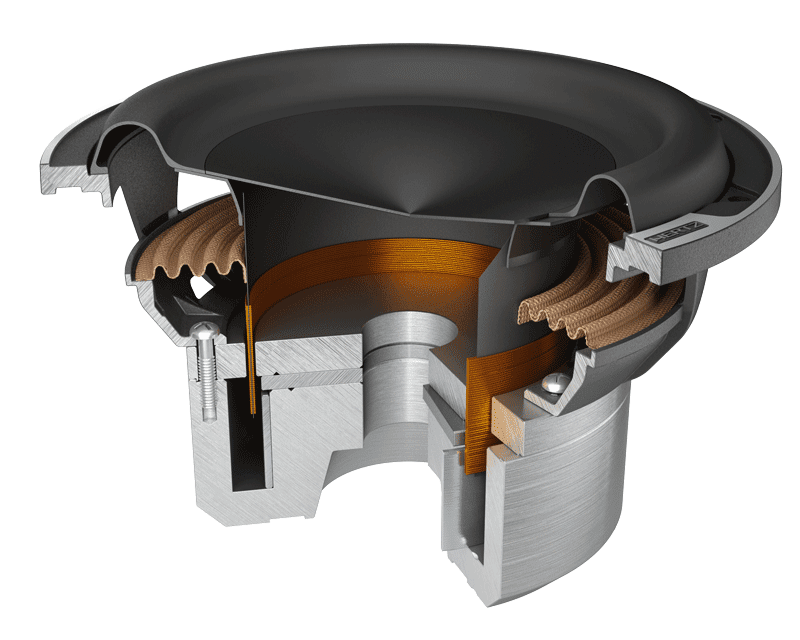
So the next time someone says that you can’t hear low-frequency distortion, you’ll know that comment makes no sense. You can hear distortion; however, it reveals itself as unwanted midbass information. No, it doesn’t stand out like garbled midrange frequencies, but it’s there. If you want a car audio system with clear, detailed, accurate bass reproduction, drop by a local specialty mobile enhancement retailer and audition their subwoofer solutions. Ask about the technologies included in the subwoofer motors that make them more accurate.
